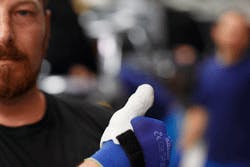BMW Uses 3-D Printing Methods to Make Customized Ergonomic PPE for Assembly Workers
As part of a pilot project at BMW Group’s Munich assembly plant, the automaker has developed an ergonomic tool designed to protect workers from excess strains on their thumb joints.
Using an additive manufacturing process, the automaker – with help from the Department of Ergonomics at the Technical University of Munich – customizes each “flexible finger cot” to match the form and size of a worker’s hand.
The orthotic devices are used in an assembly area where workers fit rubber plugs. The assembly workers have to press in the plugs with their thumbs and close the drain holes for the paint coat. To prevent unnecessary overstretching of the thumb joints, workers wear the finger cots – made of thermoplastic polyurethane – over their thumbs “like a second skin,” according to BMW.
The finger cots are open at the thumb joints to allow workers’ thumbs to move without restriction. The plastic material is reinforced at the back of the thumbs, forming a stable splint when the thumbs are stretched. The ergonomic design spreads the exertion across the entire thumb, down to the carpus.
“In initial practical tests, the feedback of workers was very positive,” BMW says, noting that it is evaluating the ergonomic device to see if it can apply the tool in other production areas.
Each Finger Cot Is Different
To customize each finger cot for its user, BMW measures the worker’s thumb with a mobile 3-D hand scanner.
Based on a standard production layout, the orthotic device is divided virtually into individual layers. Layer by layer – each of them about as thick as a human hair – the tool then is manufactured in a selective laser sintering process.
According to BMW, thermoplastic polyurethane ”is perfectly suited to making flexible orthotic devices.”
“As a rule, it is elastic, but forms solid and rigid combinations at higher material strengths,” the automaker explains. “The mechanical tensile strength is high, ensuring that the material also can resist strong, continuous strains without tearing.”
BMW notes that it has applied additive production procedures in rapid prototyping since 1989. The Rapid Technologies Center at BMW’s Research and Innovation Center in Munich produces nearly 100,000 components a year using methods such as selective laser sintering, stereo-lithography, polyjet printing, fused deposition modeling and stream smelting of metals.

